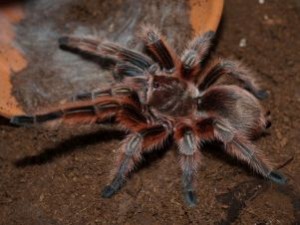Pinktoe tarantula (Avicularia avicularia)
Avicularia, New World 1 Comment »The Pinktoe Tarantula also known as the South American Pinktoe is also a very common spider across the US. Originally from South America these tarantulas love climbing. In the wild they live high up in trees and spin a lot of webbing. As with the Chilean Rosehair Tarantula, the pinktoe is also a very common arachnid to find in pet stores. It is very docile and a crowd favorite due to its magnificent pink toes (hence the name). This would be ideal for the intermediate tarantula lover. The reason we would say this wouldn’t be best for a beginner is due to its speed. Pinktoes are very quick and are known as jumpers and you might drop one if not handled appropriately. Other than their speed they are quit docile and can be the perfect pet. They usually live between 4 to 8 years with females growing to about 5 inches in length and males slightly shorter about 3.5 inches.

Habitat:
We would recommend a tall enclosure for these guys. Though fully grown they are smaller in size than most species of tarantulas these guys love climbing and having a birds eye view. I personally like the tall exo-terra terrariums as I feel its perfect for these guys. They are small so you would not need anything bigger then maybe a square foot in surface area and a foot and a half in height. Make sure you have plenty of plants for it to climb on as well as round cork bark. These animals are very active at times and you might see the enclosure covered in extensive web tubes within days. These tarantulas can also be kept in groups (communally) though we do not recommend it. You can indeed have multiple at a time in your enclosure but please note they do tend to cannibalize each other should they feel overcrowded. The pinktoe tarantula loves damp and breezy environments, they come from the wet and windy forests of Costa Rica, Venezuela and Brazil so make sure your terrarium has a humidity level between 78% to 85%. Normal room temperature should be enough for these guys but do not let it drop lower then 75 degrees. A water dish should always be available.
Feeding:
In the wild the Pinktoe tarantula typically eat insects and other arthropods but in captivity crickets do the trick just fine. They are not picky eaters but their feeding approach is quite different. They remain in a frozen state not moving for hours at a time until their food of choice comes up towards them in which they will strike in the blink of an eye. Your pinktoe does not have a limit as too how much it eats. Mine ate a cricket a day for three whole weeks once. The more you feed it the faster and bigger it grows.
Attitude:
This species is not known to being aggressive at all. When threatened most pinktoes will either jump and run away not wanting to fight at all. On occasion they will launch a stream of excrement (poo) when they feel threatened. Adults have great aim and have a range of up to 4 feet away. This can surely ruin that nice shirt you decided to wear. Their bite though venomous to insects is nothing more then a bee sting to humans. They rarely get provoked to attack in such manner but always test and see if your tarantula is in the mood to be handled before taking it out.
All in all the Pinktoe Tarantula is a great tarantula to have as a pet. They are not aggressive what so ever and are very active. Though you should handle with care due to its speed and leaps. This is more of a tarantula for someone that has already had a tarantula before.

